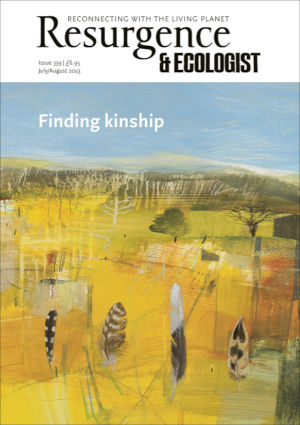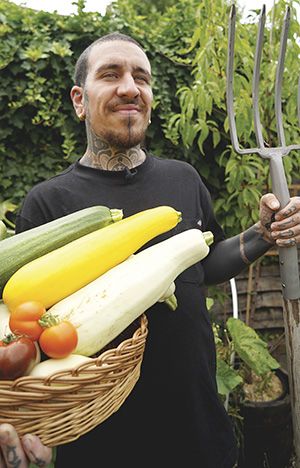Picture a little boy out foraging and fishing in the land and lakes close to his small-town Italian home with his beloved maternal grandfather, Pietro, whom he remembers as someone who lived his whole life aligned with Nature.
Sadly, Pietro died when his grandson Alessandro was just 10, but more than twenty years on, the grown-up version of that little boy still credits his grandfather with teaching him how to really connect to the land and its abundance and how to have fun doing that.
“He took me gardening but also foraging for white asparagus and apples. He taught me so much that I carried inside me even though once he passed I had nowhere to go and garden again.”
This story matters because Alessandro Vitale – or Spicy Moustache as he is known on social media to his three-million-plus followers – is a content generator whose whole life now revolves around urban gardening with a mission to grow almost all his own food, and an equally strong mission to let nothing go to waste.
His TikTok and Instagram videos are hugely engaging and recapture that sense of fun he says his grandfather instilled in him when they were out and about in the garden and the forests and the fields together.
After school, Vitale worked for a local company making handmade shoes, and it wasn’t until he moved to London in October 2015 that the seeds his grandfather had sown sprouted.
“It was so busy and grey and cold compared to Italy, and I realised I really needed to find a way to be in some part of Nature to survive it,” he says.
In reality, Vitale, who says he had originally dreamed of becoming a tattoo artist, was a long way from the nearest wild river, mountain or lake, never mind his home. He was renting a house with barely any outdoor space in North London, and so he started growing chillies in a pot on the windowsill.
No sooner had the first seed been planted than everything his grandfather had taught and shown him came flooding back, and Vitale, who was working in a tattoo studio by day and washing glasses in a cocktail bar by night, refound his passion. Before long he had moved with his fiancée, Iasmina, who is half Romanian and half German, to rent somewhere with a bit more outdoor space.
The couple now work together, so it is Iasmina behind the camera filming and directing Alessandro’s supercharged videos, and they are, he says, very much a team. And over the last seven years, they have moved five times in order to get a London home with more garden space.
One of Vitale’s gardening heroes is Charles ‘No Dig’ Dowding, author of multiple best-selling gardening books, whom he first met through a mutual acquaintance at the tail end of 2021. “I have always admired him and so I had gone to an open day with a friend of mine who had done many courses with him, and he introduced us.”
Vitale, who was by then working as a videographer, agreed to make videos for Dowding, never imagining for one second that just a year on he would be celebrating the publication of his own book, Rebel Gardening: A Beginner’s Handbook to Creating an Organic Urban Garden.
Quirky, cool and rammed with tips for getting started and keeping going growing your own food, the book contains a quote early on that I think captures something of Vitale’s essential spirit and explains why his social media channels have a combined following of over 3.7 million and rising.
He writes, “My wish is to always stay like this, living quietly in a corner of Nature.”
My wish is that Vitale, now 31, will pick up that inter-generational baton and step forward with it, because he is living proof of a generation (Z) that cares deeply about the state of the planet and finding ways to live more lightly on it rather than just talking about it. And it is an added bonus that he makes it all look so engaging and even fun. No sackcloth and ashes here!
So if you’re having a down day or just looking for inspiration in your own garden and kitchen, check out his Instagram or TikTok videos. My current favourite is his reel ‘Three Ways with Vegetable Scraps’.
REBEL GARDENING RECIPES
Alessandro shares two of his zero waste recipes with us.
Italian Quick Pickling
Being an Italian, I have grown up with giardiniera, a mix of pickled veg that we often call sottaceti. Here is a simple recipe for a fairly typical mix of veg, but feel free to mix it up and use what you have grown. It works brilliantly with courgettes, runner beans and – if, like me, you like it a little spicy – chillies.
Ingredients:
1 litre cider or white wine vinegar
2 or 3 whole cloves
2 or 3 bay leaves
¼ tsp mustard seeds
1 tsp whole black peppercorns
1 tbsp salt
1 cauliflower, florets separated
8–10 pearl onions (or 2 or 3 normal onions chopped into large chunks)
3 or 4 carrots, sliced into coins
2 celery stalks cut into chunks – fennel is a great alternative
To make:
Bring the vinegar or cider to a rolling boil in a large pan and add the cloves, bay leaves, mustard seeds, peppercorns and salt.
Add the cauliflower, onions, carrots and celery and simmer for 10–15 minutes, until the veg is cooked but still firm.
Use a slotted spoon to transfer the veg into a sterilised jam jar.
Cover the veg with the liquid and carefully close the lid tightly while it is still very hot. This should create a vacuum seal as the contents cool.
Leave the jar in a cool, dark place for at least a few days and up to a week. Once it is opened, eat the contents within a week.
Sauerkraut
One of the most famous fermented products is sauerkraut. It’s absolutely delicious on pretty much anything, and so simple to make. What is great is that it uses loads of cabbage, which once picked would go bad quite quickly and is always too much to eat in one go. This dry salt method can of course be used to ferment a host of vegetables other than cabbage. Basically, if you can shred it, use it.
Ingredients:
1 cabbage, tough outer leaves and core removed
coarse sea salt
1 tsp caraway seeds
1 tsp black peppercorns
To make:
Place the cabbage in a large mixing bowl. Blanch the cabbage with boiling water, being careful that the bowl is big enough to fit the water in. You don’t want boiling water spilling all over you.
Remove the cabbage from the water and use either a knife, a mandolin or a food processor to shred it. (You can use the discarded water as the base for an excellent vegetable stock.)
Weigh the cabbage to work out how much salt you will need. It should be 2–5% of the weight of the cabbage. If you don’t have scales, don’t worry. The average cabbage will need about 3 tablespoons of salt, and happily you don’t have to be exact.
Add the spices and massage the salt into the cabbage for about five minutes, then leave it to stand for a further five minutes. You should see a lot of brine start to come out of the cabbage and you can give it a helping hand by squeezing it.
Transfer the cabbage and spices into a sterilised jam jar and pour over the brine, making sure all the cabbage is covered. You may need to weigh it down to keep it submerged. Put the lid on, but don’t close it too tightly, because you want the CO2 to escape.
Leave the jar in a dark place at 18–22 °C for at least five days and preferably two weeks. The longer you leave it, the sourer it will get, so taste it regularly. Check the fermentation process every day and make sure you can still see bubbles of CO2 forming. Once these stop, the fermentation process is completed. If you want to stop it sooner, put the jar in the refrigerator.
Screw the lid on tightly and store in the refrigerator for up to six months.
Edited recipes from Rebel Gardening: A Beginner’s Handbook to Creating an Organic Urban Garden by Alessandro Vitale aka Spicy Moustache, published in hardback by Watkins.








